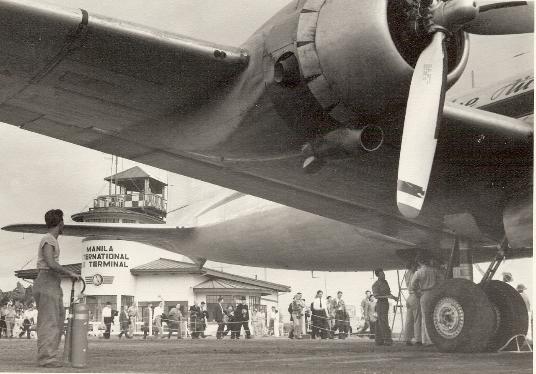I just celebrated my 69th birthday and as old age creeps, I can’t help but reminisce further on the wonderful coming of age years I had in Manila.
In the mid-Fifties, we lived in the Malate district on Remedios Street, just a couple of blocks from the Malate Church and school. Oh, I must have been 8 or 9 that one Christmas season and for some reason, I felt I just had to have a BB gun. In fact, a Daisy “air rifle” they called it. You pour BBs in a hole by the barrel, cock it, aim and shoot. It’s that easy. However, we lived in a crowded area with nothing to shoot at – but wait, there’s the Malate School and look at all those windows !
Yes, I did shoot out a couple of windows. Why, you ask ? Because I was 8 or 9 and they were there. Apparently hiding in the shadows was a nun who was on guard and alerted this criminal activity. With a savage pull on my ear, she hustled me off to the office of someone in authority, perhaps God herself. Well, to make matters worse, they called my mom, who was working at our store (Gem Gift Shop) on the Escolta, and advised her of my wrongdoing. She said that couldn’t possibly be correct because I had personally assured her that buying THIS particular “air rifle” was safe and furthermore, I promised her it couldn’t fire BBs. Ah well, not only was I guilty of shooting out the windows, I was also guilty of lying about the BB gun.
That was not the only major event of that year though, because my parents decided it was time to stop renting and own our own home. They bought a lot quite some distance from our Malate neighborhood. It was called Makati and there was a new suburban neighborhood called San Lorenzo Village. We were all very excited. We moved in around 1957. Unfortunately, my father only enjoyed our home for less than 2 years as he passed away in January 1959.
 In 1947, the government created the Rehabilitation Finance Corporation (RFC). The RFC provided credit facilities for the development of agriculture, commerce and industry and the reconstruction of properties damaged by the war. Later named Development Bank of the Philippines. By the mid-Fifties, RFC continued to offer loans to qualified Filipinos to encourage businesses to grow and people to become homeowners. My mother, being Filipina, took the opportunity to apply for a mortgage on our home. Below, Carlota sitting in the front patio of our new home.
In 1947, the government created the Rehabilitation Finance Corporation (RFC). The RFC provided credit facilities for the development of agriculture, commerce and industry and the reconstruction of properties damaged by the war. Later named Development Bank of the Philippines. By the mid-Fifties, RFC continued to offer loans to qualified Filipinos to encourage businesses to grow and people to become homeowners. My mother, being Filipina, took the opportunity to apply for a mortgage on our home. Below, Carlota sitting in the front patio of our new home.  The lot was on Melantic Street. A friend of the family, I think his name was Lebrun, was an architect and designed our home. It was a two-floor, four-bedroom home and more importantly, it was ours. It was a lovely home painted light yellow with decorative stone at the front entrance, a small yard in front and one car garage. The water pressure was low as with most homes in the Manila area. The thing that stands out in my mind was taking a shower in the upstairs bathroom and of course, just when you have soap in your hair and eyes, you run out of water. I would have to yell, “Tuuuubiiig !” and miraculously, the water started flowing again !
The lot was on Melantic Street. A friend of the family, I think his name was Lebrun, was an architect and designed our home. It was a two-floor, four-bedroom home and more importantly, it was ours. It was a lovely home painted light yellow with decorative stone at the front entrance, a small yard in front and one car garage. The water pressure was low as with most homes in the Manila area. The thing that stands out in my mind was taking a shower in the upstairs bathroom and of course, just when you have soap in your hair and eyes, you run out of water. I would have to yell, “Tuuuubiiig !” and miraculously, the water started flowing again !
Below, my mom Carlota and dad, Gopal in front of our new home (behind the photographer). Notice all the new construction on the opposite side of our street.
 (Above, our maids posing in front of our home.)
(Above, our maids posing in front of our home.)
San Lorenzo was a refreshing change from living in Malate. Here, everything was new, like nothing we’ve ever seen in Manila. Even the temperature was a bit cooler. Less population and fewer buildings, I guess. My bedroom faced the front street. Two walls held windows that provided great cross ventilation. Nowadays, with all the skyscrapers, businesses and density of homes, the power required to drive all those air conditioners and lights, plus heavy traffic must affect the ambient temperature as it seems now so stifling.
Driving along Pasong Tamo, one could see new factories and warehouses pop up but the area was still in the process of being developed. The first wire factory to operate in the Philippines was Albert Awad’s American Wire and Cable that started up their operations there in 1955, later moving to a larger manufacturing site along the South Superhighway, Parañaque City. There were still empty fields surrounding San Lorenzo. My friends and I would play “guerra” and occasionally even find leftover ammo from the real war. The lot next to ours was still empty. One day I was playing there and stumbled across a real Japanese machinegun – the kind that would sit on a tripod. I cleaned it up and painted it. Of course it was well rusted and couldn’t fire but when I played war with my friends, I was the only one with a real machine gun !
The first wire factory to operate in the Philippines was Albert Awad’s American Wire and Cable that started up their operations there in 1955, later moving to a larger manufacturing site along the South Superhighway, Parañaque City. There were still empty fields surrounding San Lorenzo. My friends and I would play “guerra” and occasionally even find leftover ammo from the real war. The lot next to ours was still empty. One day I was playing there and stumbled across a real Japanese machinegun – the kind that would sit on a tripod. I cleaned it up and painted it. Of course it was well rusted and couldn’t fire but when I played war with my friends, I was the only one with a real machine gun !
I just bought this guitar from a music store in Raon. I had ambitions of becoming the next rock and roll star (Embarrassing, isn’t it ?). My ambitions never materialized, thank goodness, but this photo does give you an idea of how open the San Lorenzo neighborhood was around 1958.
We boys also had many excursions out to Ft. McKinley past Forbes Park, where the Philippine Army was headquartered. Carefully avoiding security, we would forage the grounds, and usually come up with left over ammunition or armament. Dangerous certainly, but to a 12 year old boy, this was adventure ! Sadly, I’ve heard of a couple of boys from my school that were seriously hurt.
This large tract of land was acquired by the U.S. Government in 1902 and named Ft. McKinley after Pres. McKinley. When the Japanese occupied the Philippines in 1942, Fort McKinley was taken over and occupied as their military camp until the end of the war in 1945. 


 On May 14, 1949, Fort William McKinley was turned over to the Philippine government. It was made the permanent headquarters of the Philippine Army in 1957 and was subsequently renamed Fort Bonifacio after the Filipino hero, Andres Bonifacio.
On May 14, 1949, Fort William McKinley was turned over to the Philippine government. It was made the permanent headquarters of the Philippine Army in 1957 and was subsequently renamed Fort Bonifacio after the Filipino hero, Andres Bonifacio.
The American Cemetery and Memorial is still located there and maintained by the U.S. government. With a total of 17,206 graves, it has the largest number of graves of any cemetery for U.S. personnel killed during World War II and holds war dead from the Philippines and other allied nations. In the early 18th century, Macati was more or less referred to as swamp land; Macati meaning “when the tide has receded” due to its northern boundary along the Pasig River which regularly overran its banks.
In the early 18th century, Macati was more or less referred to as swamp land; Macati meaning “when the tide has receded” due to its northern boundary along the Pasig River which regularly overran its banks.  In 1914, legislation was passed to shorten its name simply to Makati. Before the war, there was nothing to distinguish the area other than Ft. McKinley, the Santa Ana Hippodrome and John Canson’s Sta. Ana Cabaret, billed as the largest nightclub in the world.
In 1914, legislation was passed to shorten its name simply to Makati. Before the war, there was nothing to distinguish the area other than Ft. McKinley, the Santa Ana Hippodrome and John Canson’s Sta. Ana Cabaret, billed as the largest nightclub in the world. 
Don Jose Bonifacio Roxas y Ubaldo (part of the Ayala-Roxas family) purchased the Hacienda San Pedro de Macati along with its large tract of land for ₱52,800 in 1851. It remained a sparsely populated town until the late 1930s, when Enrique Zobel de Ayala heard that the construction company L.R. Neilson Co. proposed to the government to build an airport.  Being a special aide to President Quezon, Zobel parlayed his connection and offered approximately 40 hectares of the family’s Hacienda San Pedro de Macati as a possible site for the facility. The airport was completed in 1937 and took 1000 men, 80,000 gallons of asphalt and six months to complete the field. The principal runways were laid out on what are now Paseo de Roxas and Ayala Avenue. The passenger depot was constructed on what is now Pasay Road; between the two runways was the airport tower and passenger station, designed in the shape of an airplane.
Being a special aide to President Quezon, Zobel parlayed his connection and offered approximately 40 hectares of the family’s Hacienda San Pedro de Macati as a possible site for the facility. The airport was completed in 1937 and took 1000 men, 80,000 gallons of asphalt and six months to complete the field. The principal runways were laid out on what are now Paseo de Roxas and Ayala Avenue. The passenger depot was constructed on what is now Pasay Road; between the two runways was the airport tower and passenger station, designed in the shape of an airplane.
It was named after its builder and principal investor, L.R. Nielson. Laurie Reuben Nielson was a British man born in New Zealand who arrived in Manila with his wife in the mid 1930s. He and his American wife, Annette, had two sons. In Manila, his first goal was to establish a business, thus the creation of the firm L. R. Nielson & Co. He was mainly involved in the securities and stock brokerage business, mining, and importing. Nielson was also part of the board of “The Hongkong and Shanghai Banking Corporation.” 
Left – Len Coote and L.R.Nielson display their handball trophies at Wack Wack Country Club (courtesy of L. Nielson)
I received an email from Nielson’s son, Lindsay, who wrote an article about his family and their subsequent experience during their internment at Santo Tomas. “Nielson Airport played a strategic role in the battle for the Philippines. The two military airports, Clark Field and Nichols Field, had been bombed but our little civilian airport was spared although it was constantly being strafed. Later in the war it went on to become the headquarters for the Far East Army Air Force.”  Above: L.R. Nielson (front with white suit) enjoys his despedida party at the Wack Wack Country club. (courtesy of L. Nielson)
Above: L.R. Nielson (front with white suit) enjoys his despedida party at the Wack Wack Country club. (courtesy of L. Nielson)
While his family was interned at Santo Tomas, L.R. Nielson was sent to Hong Kong imprisoned with other British Nationals where he died. Lindsay writes, “My mother, brother and I were ordered to leave our home on Dewey Blvd. on magnificent Manila Bay to the newly converted University/Prison Camp for American prisoners of war. We were initially allowed only those possessions that we could ultimately bring with us.” After being liberated, they were repatriated back to the U.S. and met by their families in San Francisco. 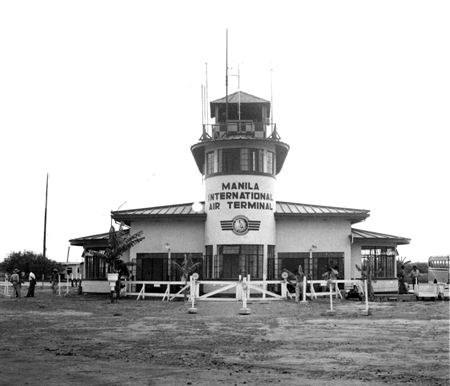
Manila International Air Terminal was the only commercial airport in Manila from 1937 to 1947. Philippine Airlines, then owned by Don Andres Soriano, operated domestic flights from Manila to Baguio and Paracale with 9-passenger twin-engine planes flown by American and Filipino pilots. I still remember venturing out past the edges of Ayala Avenue, you could still see some remaining portions of the runway macadam. The site is now the Filipinas Heritage Library.
Then war broke out. After over three years of Japanese occupation, the invaders were defeated but Manila lay in ruins. Thousands were left homeless and the problem exacerbated when hordes of people from the provinces immigrated into the city, eager to find jobs. In addition, the birth rate rose dramatically. From a prewar count of 450,000, Manila’s population vaulted to more than two million by July 4, 1946. Living quarters were at a premium as reconstruction efforts struggled to rebuild and renew the desolated city. People began to look outwards towards the city’s edges.
Born in Manila the son of a Scottish father and a Filipina mestiza mother, Joseph R. McMicking married into the Zobel family that owned a thousand hectares of open land in Makati. McMicking had a vision. Seeing the complete destruction of Manila, especially the devastated neighborhoods of Malate and Ermita, he envisioned a residential subdivisions and a financial center that would replace Manila’s downtown area.
Below, left to right: J. R. McMicking, Alfonso R. Zobel de Ayala, Enrique O. Zobel 
The post-war move of the Manila Polo Club from its prewar Dewey Boulevard location and the low land prices at ₱8 per square meter attracted more affluent families into the first community, Forbes Park. San Lorenzo Village was developed in 1954 for upcoming middle class families. It was quintessential suburbia with a mix of Filipino and American families. Many of my friends lived close by. Down the street were the Stullers, the Hamms, the Litwins and Judy Budd and her family lived at the corner of Hidalgo and Melantic. Her father worked for Goodyear. Their home is shown below (courtesy Judy Budd Stevenson).
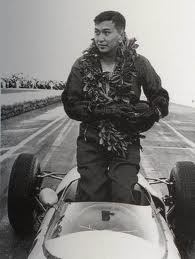 An older friend of mine in those days was Dodjie Laurel who lived on Ponce Street. He was a great guy with great toys. At that time, he had a ’62 Corvette and a twin-engined go-kart. Every once in a while, he would indulge me by allowing me to borrow his go-kart which I’d tear down Pasong Tamo on many occasions. He was always friendly towards us teens; a sort of mentor. We used to drag race at an informal track somewhere in Mandaluyong. (update: I’ve just been informed that was on Ortigas Ave.-thanks to Jay Gutierrez). He was passionate about motor sports and raced regularly. Dodjie Laurel perished in a flaming death in the Macau Grand Prix on Nov. 19, 1967 at only age 35. I remembered him fondly and always loved his old Corvette so I ended up getting a similar one. I still have it today.
An older friend of mine in those days was Dodjie Laurel who lived on Ponce Street. He was a great guy with great toys. At that time, he had a ’62 Corvette and a twin-engined go-kart. Every once in a while, he would indulge me by allowing me to borrow his go-kart which I’d tear down Pasong Tamo on many occasions. He was always friendly towards us teens; a sort of mentor. We used to drag race at an informal track somewhere in Mandaluyong. (update: I’ve just been informed that was on Ortigas Ave.-thanks to Jay Gutierrez). He was passionate about motor sports and raced regularly. Dodjie Laurel perished in a flaming death in the Macau Grand Prix on Nov. 19, 1967 at only age 35. I remembered him fondly and always loved his old Corvette so I ended up getting a similar one. I still have it today.
In 1956, the Philippine Airlines Pilot Union (ALPAP) comprised of over 200 former Philippine Air Force and U.S. Air Force pilots requested a subdivision from the Ayala Corporation. Mainly through the efforts of Capt. Anthony O’Brien who was the current president of ALPAP and with the support of McMicking, Phase 1 of Bel-Air Village was opened in 1957 at the price of ₱15 per square meter for pilots and ₱30 per square meter for non-pilots.
 Above my mom, Carlota with a couple of her friends taken by the Luneta around 1940.
Above my mom, Carlota with a couple of her friends taken by the Luneta around 1940.
Bel-Air Village officially became the third subdivision to be developed by the Ayala Corporation. Capt. O’Brien chose the name Bel-Air as the pilots wanted a name that included the word “air”.  The streets were wider, cleaner and lined with trees and grassed sidewalks. The homes ranged from modest to grand and were designed in a more modern, airy style with gardens, yards and low walls to attractively display the homes. Of course, these were all “gated” communities with security guards stationed at all entrances to keep the “riff-raff” out. As these communities grew to house the rich and nearly rich and the BMWs and Mercedes filled the garages, the walls grew taller, more security guards were employed and more armed checkpoints sprung up.
The streets were wider, cleaner and lined with trees and grassed sidewalks. The homes ranged from modest to grand and were designed in a more modern, airy style with gardens, yards and low walls to attractively display the homes. Of course, these were all “gated” communities with security guards stationed at all entrances to keep the “riff-raff” out. As these communities grew to house the rich and nearly rich and the BMWs and Mercedes filled the garages, the walls grew taller, more security guards were employed and more armed checkpoints sprung up.
We even had a park in San Lorenzo – pretty much an empty field when it opened but they installed monkey bars and assorted little rides for the kiddies. It was also where the local teens hung out. My buddies and I formed a basketball team called “The Vampires” – actually I was what they called their manager (whatever that entailed). Recognize anyone in the photo below ?
(Below the view from our home out onto Melantic Street.)
 But in the Fifties, it was still a simpler life. I remember catching a jeepney from the corner of Taft and Highway 54 (EDSA) that took me right into San Lorenzo.
But in the Fifties, it was still a simpler life. I remember catching a jeepney from the corner of Taft and Highway 54 (EDSA) that took me right into San Lorenzo.  I recall that one of the first stores to open in the area was a branch of the Acme Grocery Store at the entrance of Forbes Park. It fit right in, being a modern supermarket in the American style. The overhead view of Forbes shows the Acme at bottom left just across the street from the Franciscan Santuario de San Antonio church (photo thanks to Lito Ligon).
I recall that one of the first stores to open in the area was a branch of the Acme Grocery Store at the entrance of Forbes Park. It fit right in, being a modern supermarket in the American style. The overhead view of Forbes shows the Acme at bottom left just across the street from the Franciscan Santuario de San Antonio church (photo thanks to Lito Ligon). 
A sort of open strip mall called Makati Commercial Center was built at the crossroads of Makati and Ayala Avenues in the late 1950s. A new theater, Rizal Theater, was built at the corner of Makati Road and Ayala Avenue. 
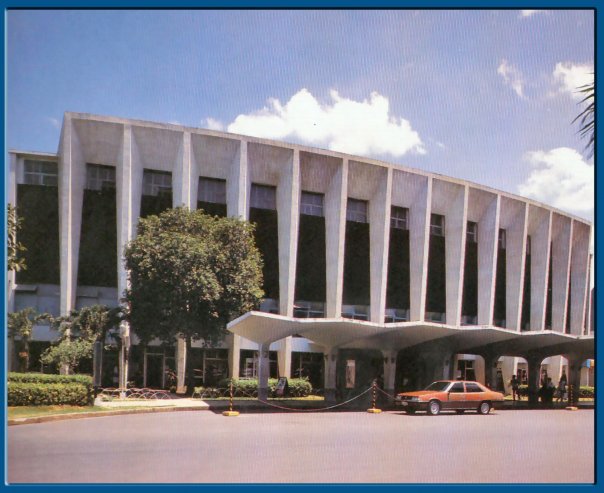
It was one of the most modern theaters I had seen, with its cold air conditioning including balcony seating where young teens might meet, hold hands and even steal a kiss. It even had a small restaurant off the lobby called Leila’s. 


Rendering and model of Rizal Memorial Theater designed by Architect Juan Nakpil which was intended as part of the Rizal Memorial Cultural Complex originally intended for completion by 19 June 1961, in time for Jose Rizal’s birth centennial. Due to lack of funds, the theater was not built but redesigned as the Rizal Theater at the Makati Commercial Center, now demolished. (Thanks to Isidra Reyes)
Along Makati Road was also the Nomads Club where I happened to watch my dad with other British and Indians playing cricket there on Sundays. To this day, I have no conception of how cricket is played but it was fun watching my non-athletic dad hit with that weird looking bat.
I spent many a day at the San Lorenzo Park which was located next to Assumption which had moved their elementary grades from their Herran location in 1958. The following year, the school opened its doors to college-bound young women, and the College moved there in 1959. I wonder if I enjoyed the park as much as I enjoyed checking out the cute girls in their uniforms ? (photo below thanks to Lito Ligon)
Getting around Makati required transportation – it was big. Nothing like living in the city where the sari-sari was just around the corner, the Malate Church was two blocks away, the Paco Market, the Gaiety Theater and a lot of restaurants and stores on Mabini were a short jeepney ride away.
(Below – aerial view of Makati Commercial Center with Ayala Ave. on the left heading towards Forbes Park – late 1960s)  In Makati, you needed a car. Public transportation did not abound, especially if I wanted to go see some of my friends like Johnny Green or Baby O’Brien who lived in Bel-Air Village or the Awads and Winters girls in Forbes or visit the “Teen Room” at the Polo Club. So what was I to do ? I was 13, the driving age was 18 at the time. Well, mom sent our driver to the City Hall and with a few appropriately placed pesos, I was the owner of a brand new driver’s license. Wow – now I was loosed onto society with our 55 Chevy Bel-Air.
In Makati, you needed a car. Public transportation did not abound, especially if I wanted to go see some of my friends like Johnny Green or Baby O’Brien who lived in Bel-Air Village or the Awads and Winters girls in Forbes or visit the “Teen Room” at the Polo Club. So what was I to do ? I was 13, the driving age was 18 at the time. Well, mom sent our driver to the City Hall and with a few appropriately placed pesos, I was the owner of a brand new driver’s license. Wow – now I was loosed onto society with our 55 Chevy Bel-Air.
The Makati area actually had its own motorcycle Police unit. The only catch was you had to have your own motorcycle to be part of that unit as the Rizal province (Makati was made part of greater Manila in 1973), didn’t have enough budget at the time to buy them all the appropriate equipment. The motorcycle patrol used to hang out at the crossroads of Highway 54 (EDSA) and McKinley Road with their assortment of Harley Davidsons and Indians. These were big bikes with foot clutches and gear shifts by the massive gas tanks.  My buddies and I would traipse over to where the police sat languidly in the shade of large trees, and beg to ride their bikes…borrow them, so to speak. With a smile, a wink, and a nod plus a couple of cartons of blue seal cigarettes, we were off. Two or three of us on large Indian motorcycles with plastic windshield and POLICE written on them and skinny little boys driving to their hearts’ content. Ah…those were the days. How on earth did we ever get away with that ? (Above photo is the exact spot they hung out. )
My buddies and I would traipse over to where the police sat languidly in the shade of large trees, and beg to ride their bikes…borrow them, so to speak. With a smile, a wink, and a nod plus a couple of cartons of blue seal cigarettes, we were off. Two or three of us on large Indian motorcycles with plastic windshield and POLICE written on them and skinny little boys driving to their hearts’ content. Ah…those were the days. How on earth did we ever get away with that ? (Above photo is the exact spot they hung out. )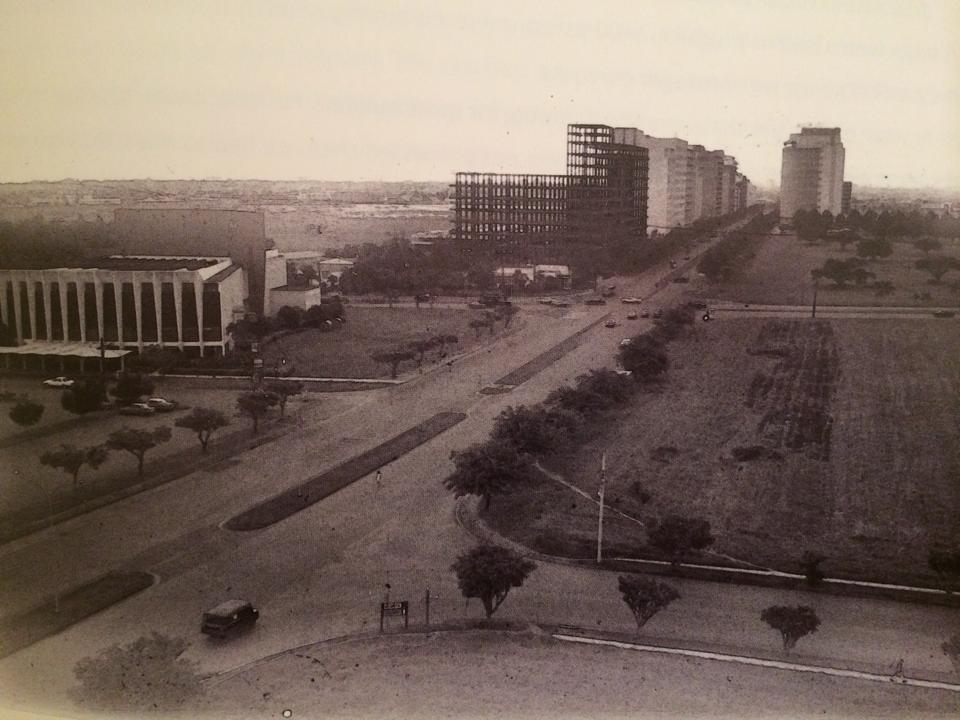 So, in 2012, my wife and I returned to Manila and stayed at the Dusit Thani in Makati. A friend sent their car over to pick us up for a wonderful dinner at the Luchangco’s beautiful home in Forbes Park. It’s a short drive but the traffic stalled out on Ayala Avenue. While we were waiting I mentioned to the driver that at one time, I had gotten a speeding ticket on Ayala for going 85 mph. As you can see from the photo above, there wasn’t much traffic then. He looked at me incredulously, thinking I was just kidding. I said, “Talaga naman !” It was in 1961. We both laughed. He wasn’t even born yet.
So, in 2012, my wife and I returned to Manila and stayed at the Dusit Thani in Makati. A friend sent their car over to pick us up for a wonderful dinner at the Luchangco’s beautiful home in Forbes Park. It’s a short drive but the traffic stalled out on Ayala Avenue. While we were waiting I mentioned to the driver that at one time, I had gotten a speeding ticket on Ayala for going 85 mph. As you can see from the photo above, there wasn’t much traffic then. He looked at me incredulously, thinking I was just kidding. I said, “Talaga naman !” It was in 1961. We both laughed. He wasn’t even born yet.
I went to the American School located in Pasay on Donada Street. So, every day, the bus leased from Don Bosco would pick us up and we would make the short journey down Pasay Road past the Don Bosco school to Pasong Tamo, then Buendia to Taft and finally to Donada Street. The bus would pass by the Don Bosco Technical Institute. It was a private Catholic school operated by the Salesians of Don Bosco. It was a smaller school at the time, built in 1955, starting out as a grade school with only a couple of buildings and basketball court but at a prime location on the edge of San Lorenzo Village and Pasay Road.
As our student population grew, the old Donada campus was abandoned for the new American School in Bel-Air. Elementary grades started in June 1961 with high school classes starting in 1962. The new campus offered modern buildings, air-conditioning, cafeteria and large grounds. The style was more reminiscent of an American-style school.
 Our school paper featured the move, “On Tuesday June 20, 1961, the Elementary School opened with an enrollment of 647 children in Grades Kindergarten to VI.” The name was later changed to International School of Manila and a beautiful new campus relocated to Ft. Bonifacio.
Our school paper featured the move, “On Tuesday June 20, 1961, the Elementary School opened with an enrollment of 647 children in Grades Kindergarten to VI.” The name was later changed to International School of Manila and a beautiful new campus relocated to Ft. Bonifacio.
My mom and I left Manila for good in 1962 after I finished high school. I still miss that old school. It is now occupied by Arellano Law School. A group of us alumni visited in 2012. It looked pretty much the same. Ah, the memories were oozing out of the old cement walls and classrooms.
In 2004, my wife Michelle and made a “balikbayan” trip to Manila after an absence of over 40 years. I was anxious to see what the old neighborhood and particularly, our old home, looked like. We drove through San Lorenzo and everything looked much the same, except the streets looked a little narrower than I remembered; the homes a little shabbier with high walls but still, many of my friends’ homes were still there. Everything looked older of course. We got to Melantic Street and then I found, much to my disappointment, our house was gone. Sold and torn down to make way for a new home. I guess it’s true – you can never go back home. Well, that’s progress I guess. 
Also, please visit my Facebook page MANILA NOSTALGIA for more stories and photos from our over 3800 members.




